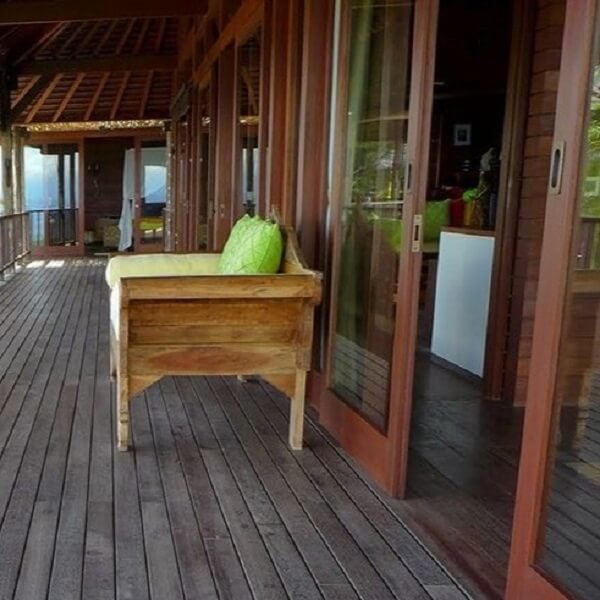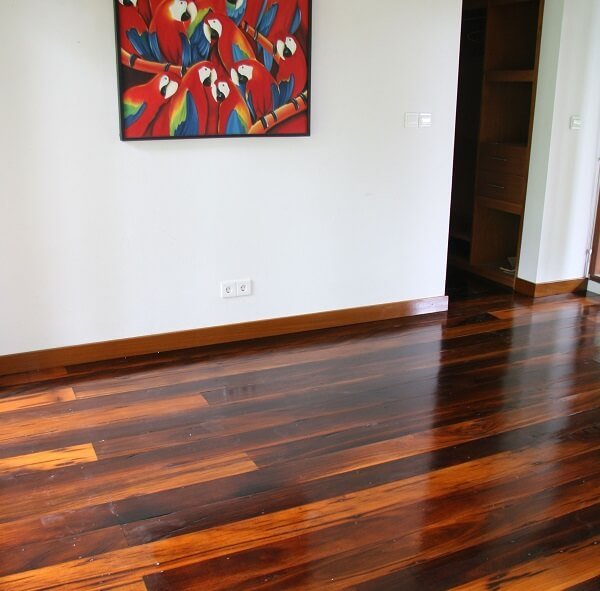Two unavoidable factors that will impact upon wood in an exterior application are sun and rain. They will have an effect on the wood's colour as many clients ask us about. Why is it so important to consider these factors from the outset, and what can you do to minimise their impact?
Fully exposed ironwood decking by Kaltimber
Not many of us dislike the sun, but when it comes to timber, the sun can be a powerful factor in modifying the potential lifespan of our timber structure.
Wood that is kept dry and away from sunlight in an indoor application will last indefinitely. But what happens when wood is exposed to the sun’s rays and moisture from the rain? In simple terms, the surface of the wood starts to break down and decay, and the wood begins to split, rot, warp, lose its rich colouring and literally fade to grey.
That is, if you’re not dealing with ironwood (Kalimantan ironwood -Eusideroxylon zwageri) of course! This isn’t just a “we want to sell to you” statement. We believe this as much as we guarantee our wood for 25 years. Of course the colour will change, but the woods’s integrity won’t.
Our decking will gradually change colour, with clear to dark orange/red and if fully exposed as the previous picture, it will take 3 months for the colour to change to grey, and about 6 months if semi-exposed.
Decay and degradation in timber is caused by a variety of factors: attack from fungi and bacteria, attack from the sun’s UV rays and from moisture, and biological attack including termites and borers. We call these ‘biological hazards’. Timber is usually rated against its ability to withstand these biological hazards, and it is wise to explore timber durability and strength gradings before you start building to choose the best timber for the right application to maximise the life of your structure.
Solar degradation or weathering occurs when UV light from the sun causes chemical changes in the wood cells and breaks down the lignum and cellulose in timber making it brittle, whilst also dying out and shrinking the surface of timber in comparison to its inner section, causing the timber to split. The best way to protect against this is by simply ensuring that you use an exterior grade timber with an interlocking grain to reduce splitting, and a dense oily consistency to resist drying out. Another essential consideration is to build out solar attack by designing your structure so that east and west timber walls are shaded from setting sun and that all other timber elements are shaded from above. Adequate eaves can greatly increase the lifespan of your timber.
Semi-exposed decking
For both rot and weathering prevention, you can apply a finish such as a paint, oil or a stain. I won’t go into great detail here as timber finishing is a huge topic that will be covered in an upcoming edition. In brief, the best protection against weathering is really pigment as it effectively blocks the ultra violet rays from the sun. This is why when you remove the paint from a 100 year old timber house, the timber underneath looks new. However, it is not particularly practical for wood lovers as the downside is you can’t see the beautiful properties of the wood. Another option is a permeable finish such as wood oil. The benefits of using wood oil is that unlike a polyurethane finish, it penetrates into the wood cells and expands and contracts as the wood swells and shrinks in response to changes in the weather. The downside is it doesn’t provide lasting protection and you will need to re-apply the oil every year or so. We recommend a high-quality natural permeable oil-based sealer such as Tung oil which can be bought in our showroom.
Indoor, the sun exposure might play a role as well depending on its position in the house, and if the windows have a UV treatment or not. Without or with limited UV, ironwood will keep a reddish colour perfect for a sense of warmth and luxury.
Interior ironwood flooring
Remember it’s the combination of water and sun that cause most trouble, so design your house so the timber stays nice and dry and preferably out of the sun.
Do not hesitate to contact us if you have more questions about how weather and sun affect your wood!




